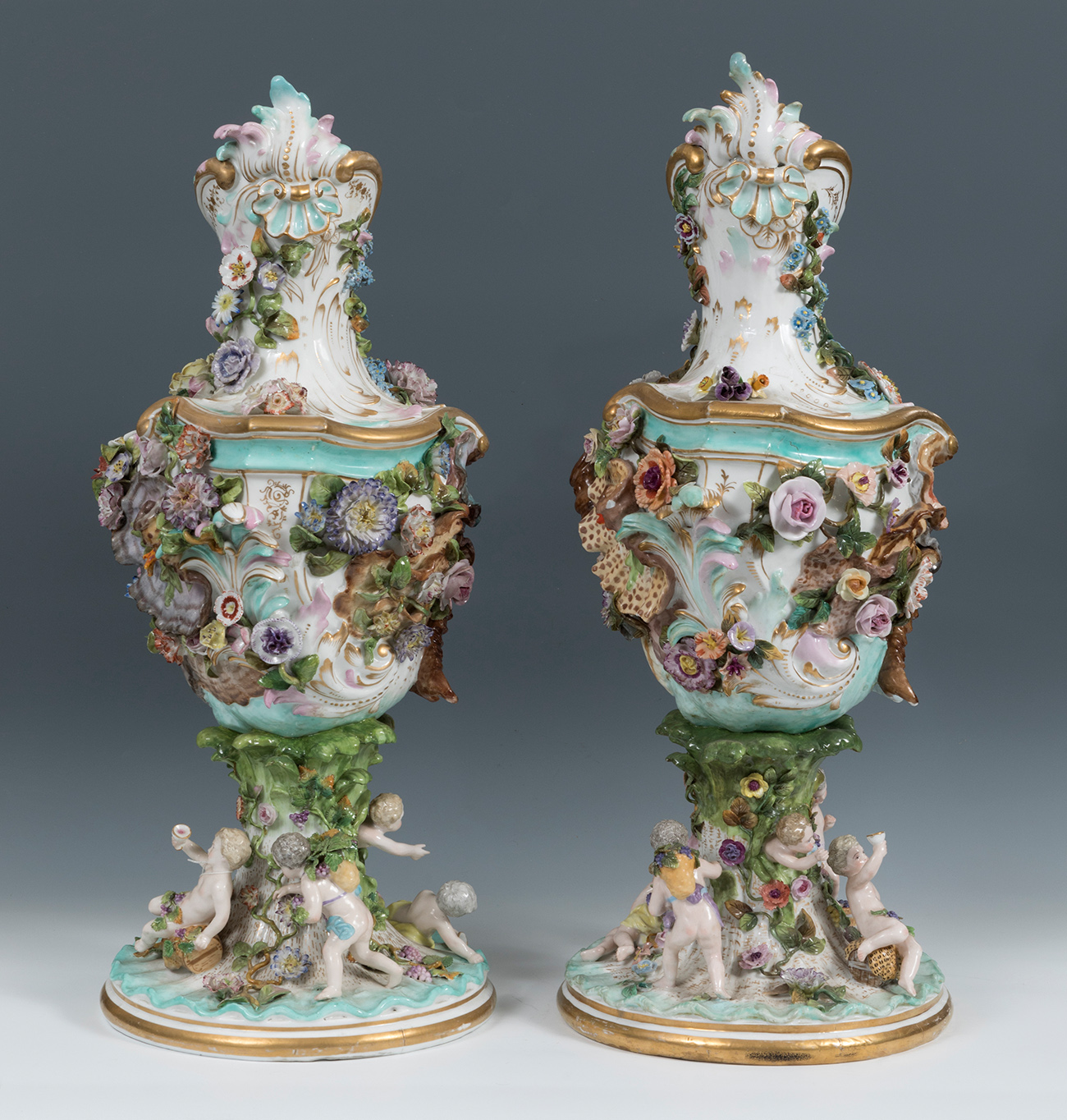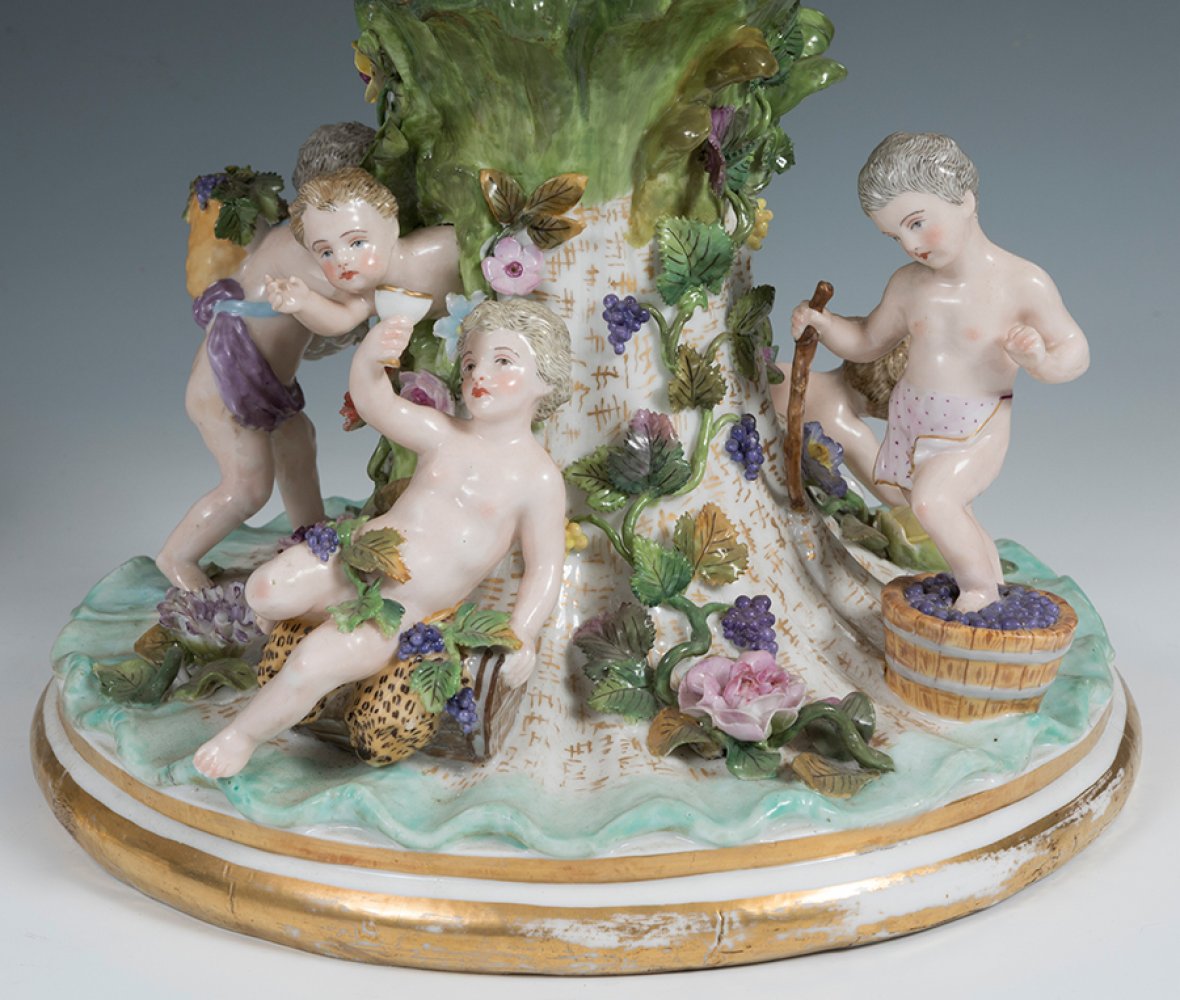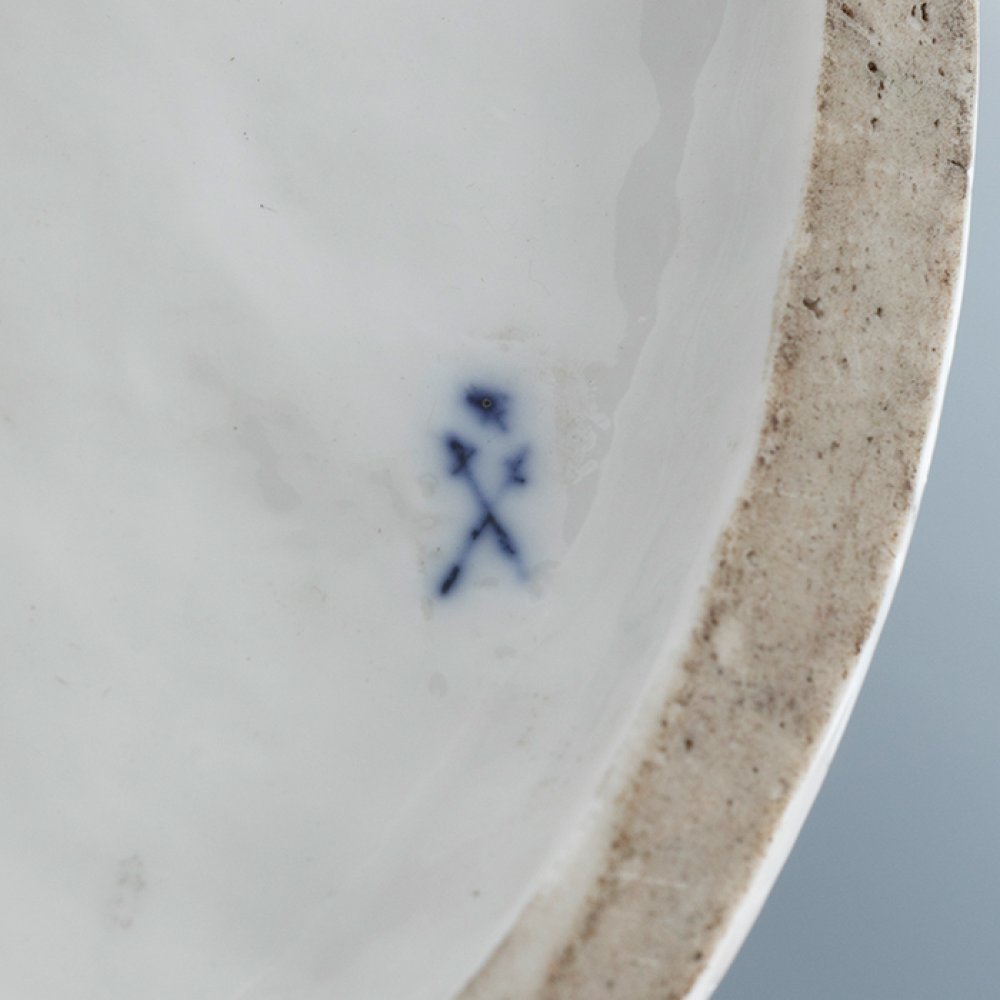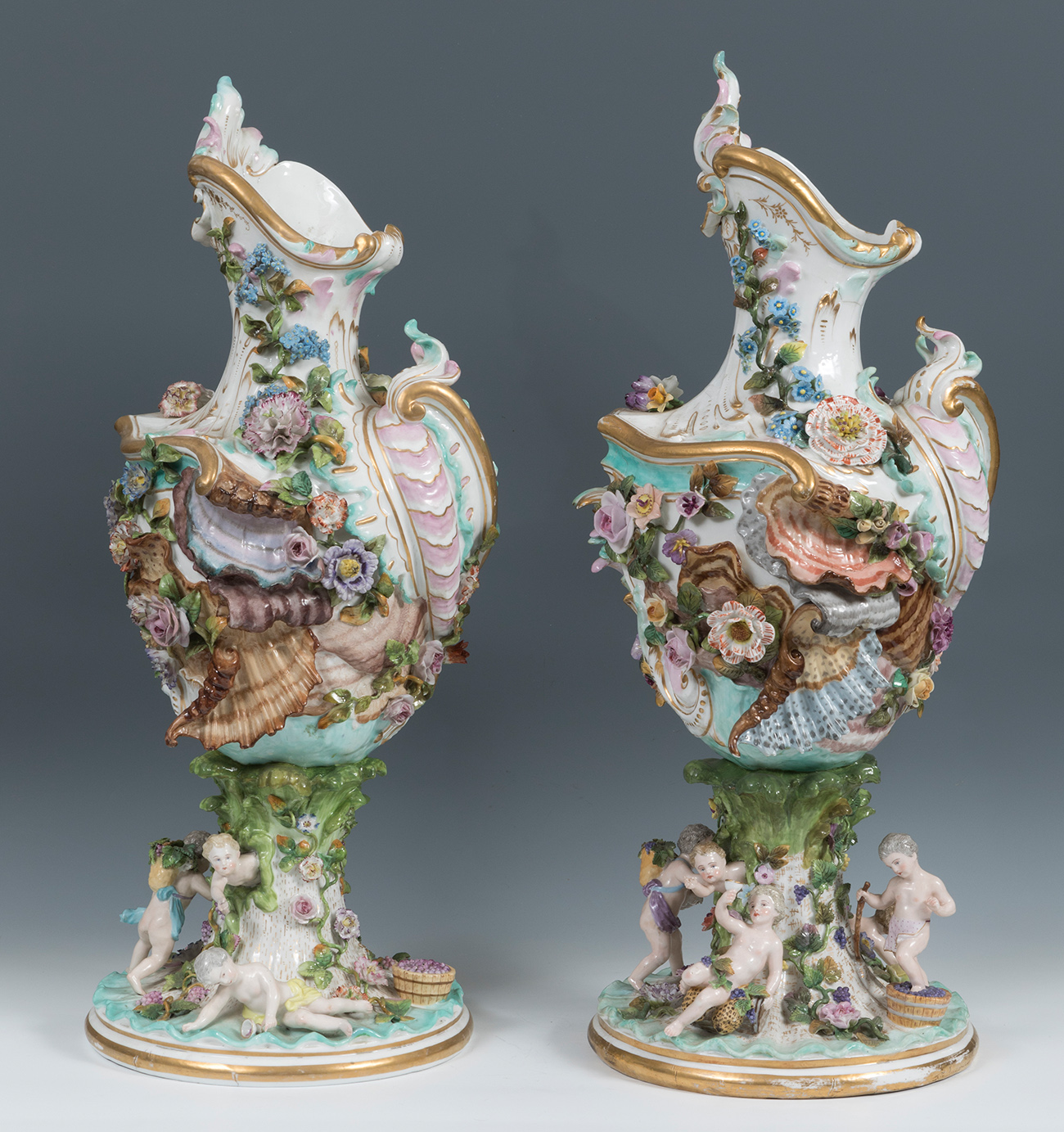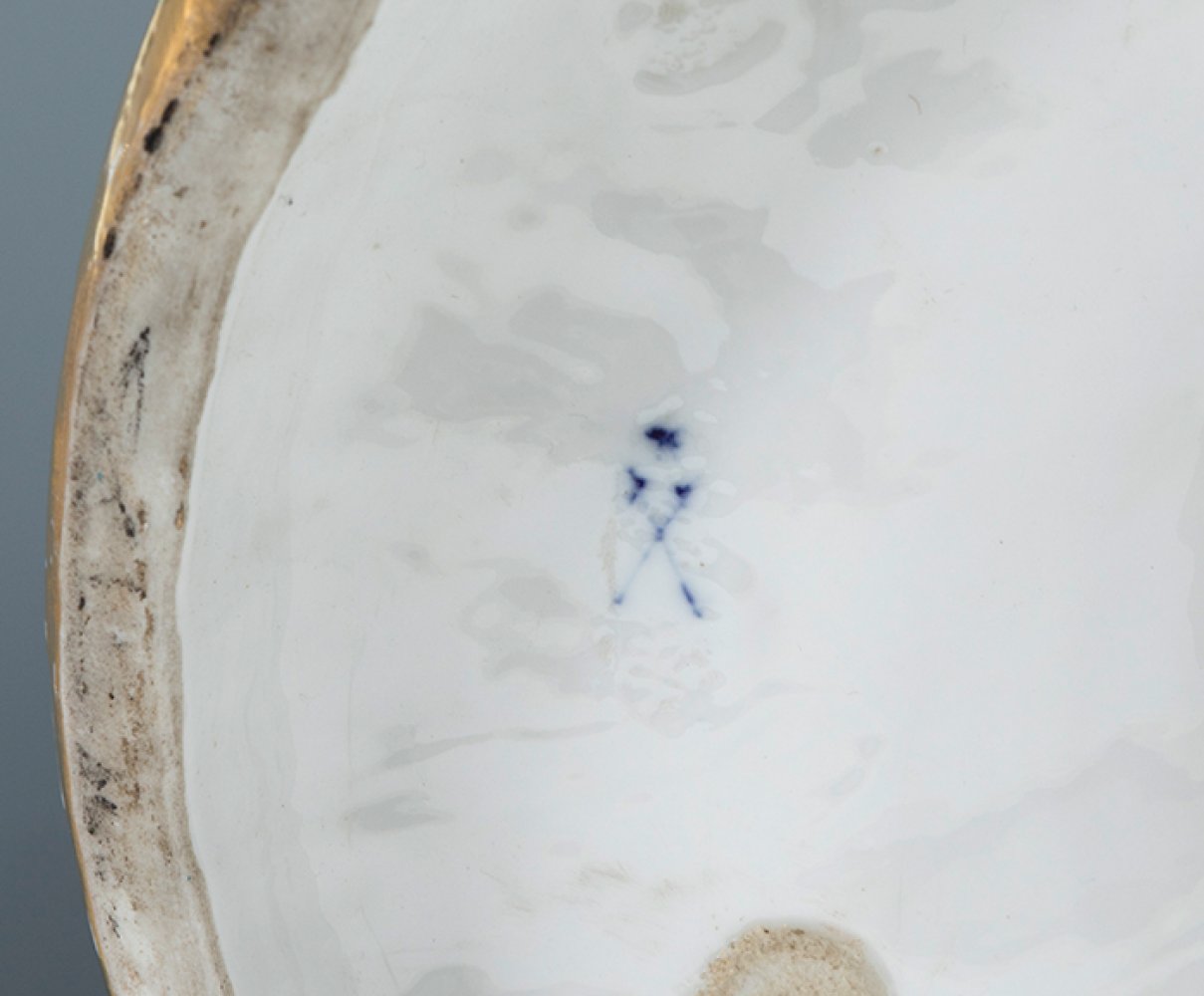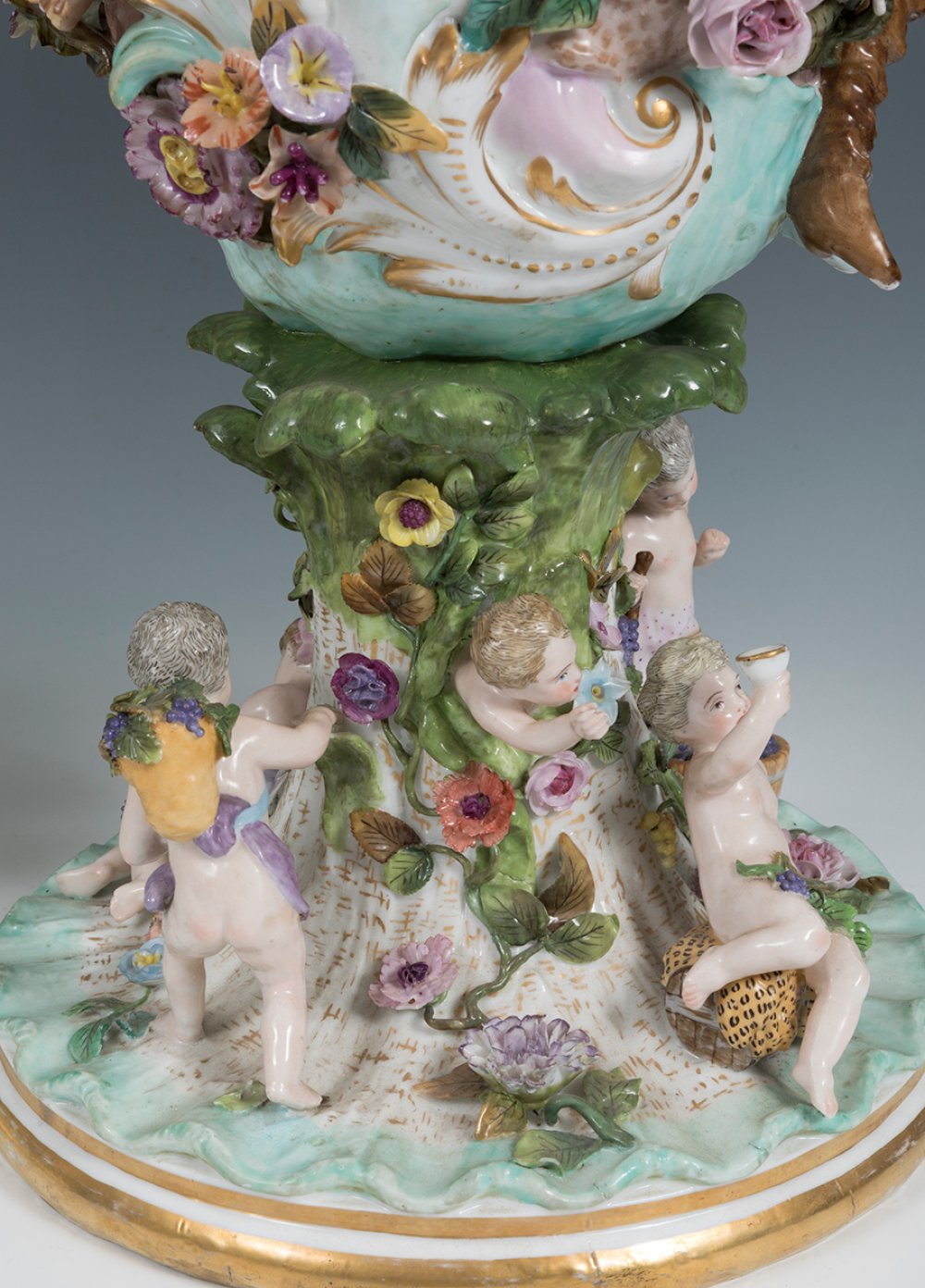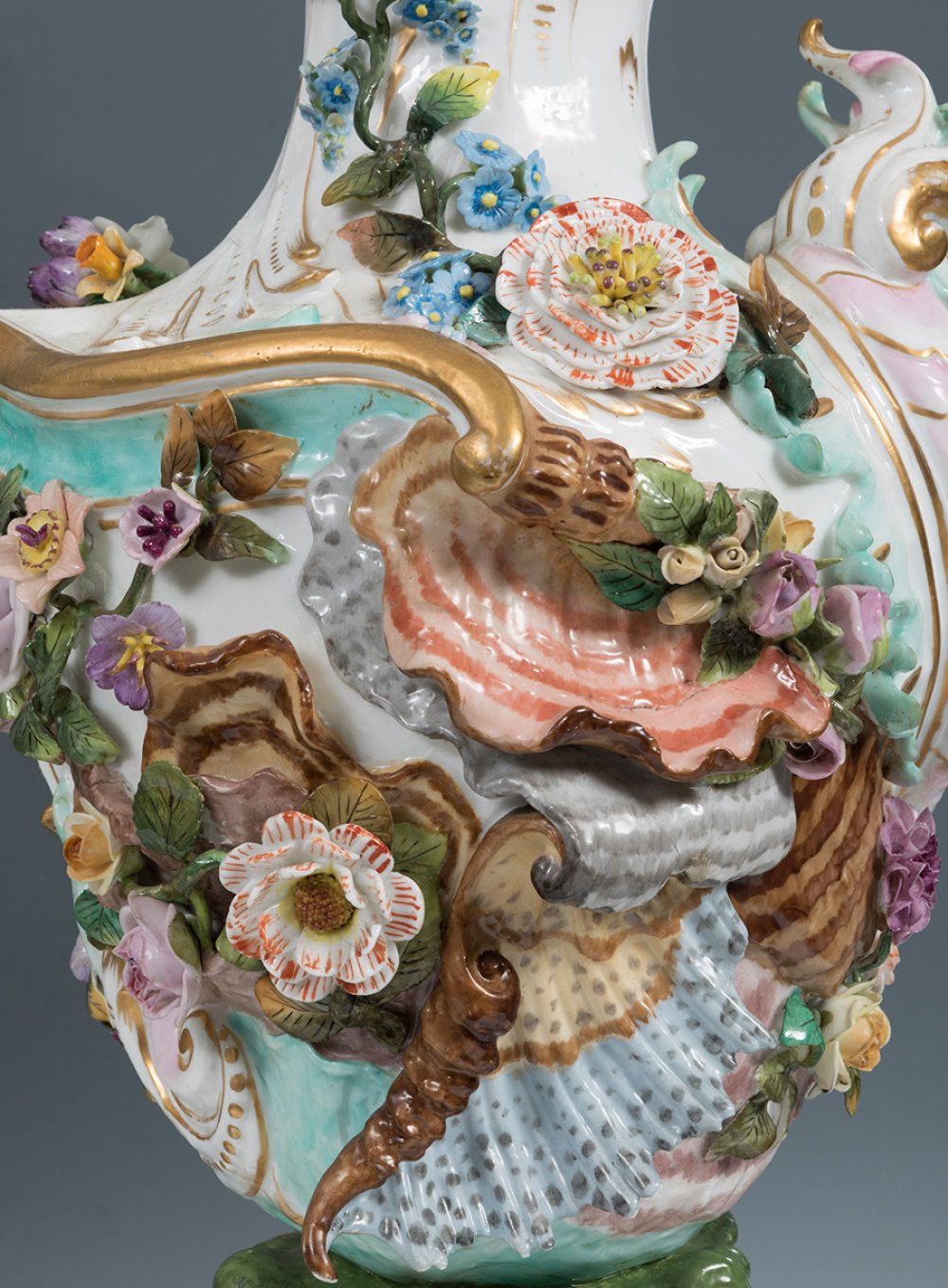13
Pair of vases from the MEISSEN MANUFACTURE. Germany, 19th century.Enamelled porcelain.With mark.
Enamelled porcelain.
With mark.
Measurements: 76 x 30 cm.
Pair of vases in rococo style, made in the Manufacture of Meissen in the 19th century following the models of the previous century, although approached from a more ornamental and fantastic point of view, already clearly nineteenth century. The basic rules of full rococo are respected: The structure is practically hidden by the decoration in relief, of great bulk; profiles of sinuous lines, general asymmetry and also in the details, absolute naturalism in the decoration and floral theme combined with the figures of children, very typical of European production from the 18th century onwards. Thus, the design is directly inspired by the natural world, with a predominance of flowers modelled by hand and applied separately, whose realism almost deceives the eye. We also see rockery crests, naturalistic scallops, far removed from the classical shell, all kinds of leaves and stems and, at the base, children playing, drinking and picking flowers.
The Meissen Manufactory was the first European factory to produce genuine porcelain. The manufacture was started by the scientist Ehrenfried Walther von Tchirnhaus in 1708, and after his untimely death his work was continued by Joahnn Friedrich Bóttges, who remained virtually imprisoned on the factory premises in order to protect the secret of the porcelain formula. Meissen porcelain production began in 1710, a year after the factory was founded by Augustus the Strong, and soon achieved great fame throughout Europe.
In order to prevent forgeries, he introduced his famous mark, two crossed swords, in 1720, making his one of the oldest pottery marks in existence (it still remains on the wares of Meissen's heir firm, the Staatliche Porzellan-Manufaktúr Meissen GMBHB). Initially, Meissen's production imitated oriental production, especially Japanese kakiemon ("indianische Blumen"), although enamelled pieces with landscape, floral and gallant themes were also produced, the latter derived from the paintings of the French artist Antoine Watteau. However, in 1717 a former Meissen worker, Samuel Stáltzel, sold the secret of porcelain to a manufactory in Vienna, and by 1760 there were about thirty manufacturers of genuine porcelain in Europe. However, most of these manufactories produced soft-paste porcelain, due to the difficulty of accessing kaolin, the basic ingredient of authentic (hard-paste) porcelain. After an initial production of rococo style, which evolved towards neoclassical in the 1750s, in the 19th century we witnessed a new style known as "second rococo", inspired by the first productions of Meissen, which coexisted with other historicisms, among them the sculpture in rounded bulk, mainly in enamelled porcelain, following models of both rococo and neoclassical.
Enamelled porcelain.
With mark.
Measurements: 76 x 30 cm.
Pair of vases in rococo style, made in the Manufacture of Meissen in the 19th century following the models of the previous century, although approached from a more ornamental and fantastic point of view, already clearly nineteenth century. The basic rules of full rococo are respected: The structure is practically hidden by the decoration in relief, of great bulk; profiles of sinuous lines, general asymmetry and also in the details, absolute naturalism in the decoration and floral theme combined with the figures of children, very typical of European production from the 18th century onwards. Thus, the design is directly inspired by the natural world, with a predominance of flowers modelled by hand and applied separately, whose realism almost deceives the eye. We also see rockery crests, naturalistic scallops, far removed from the classical shell, all kinds of leaves and stems and, at the base, children playing, drinking and picking flowers.
The Meissen Manufactory was the first European factory to produce genuine porcelain. The manufacture was started by the scientist Ehrenfried Walther von Tchirnhaus in 1708, and after his untimely death his work was continued by Joahnn Friedrich Bóttges, who remained virtually imprisoned on the factory premises in order to protect the secret of the porcelain formula. Meissen porcelain production began in 1710, a year after the factory was founded by Augustus the Strong, and soon achieved great fame throughout Europe.
In order to prevent forgeries, he introduced his famous mark, two crossed swords, in 1720, making his one of the oldest pottery marks in existence (it still remains on the wares of Meissen's heir firm, the Staatliche Porzellan-Manufaktúr Meissen GMBHB). Initially, Meissen's production imitated oriental production, especially Japanese kakiemon ("indianische Blumen"), although enamelled pieces with landscape, floral and gallant themes were also produced, the latter derived from the paintings of the French artist Antoine Watteau. However, in 1717 a former Meissen worker, Samuel Stáltzel, sold the secret of porcelain to a manufactory in Vienna, and by 1760 there were about thirty manufacturers of genuine porcelain in Europe. However, most of these manufactories produced soft-paste porcelain, due to the difficulty of accessing kaolin, the basic ingredient of authentic (hard-paste) porcelain. After an initial production of rococo style, which evolved towards neoclassical in the 1750s, in the 19th century we witnessed a new style known as "second rococo", inspired by the first productions of Meissen, which coexisted with other historicisms, among them the sculpture in rounded bulk, mainly in enamelled porcelain, following models of both rococo and neoclassical.
21st September - Decorative Arts
Sale Date(s)
Venue Address
General delivery information available from the auctioneer
Setdart offers Worldwide shipping
PICK UP IN ROOM: You can come and pick up your lots in our offices (Barcelona, Madrid or Valencia). At the moment of the withdrawal, you will be able to accept the current conditions of the lot by means of a document that you will sign.
YOU CAN SEND ANOTHER PERSON TO PICK UP: This person must present a signed authorization that you can find in our web page by accessing from BUY AT SETDART- LOGISTICS-DOWNLOAD AUTHORIZATION DOCUMENT. You can also send an e-mail with the requested data in AUTHORIZATION DOCUMENT to admin@setdart.com
Important Information
25% buyer´s premium
21% buyer´s premium at www.setdart.com
Terms & Conditions
The maximum period to pay the lots is 7 working days. You can pay either via bank transfer or with credit card through our platform www.setdart.com (we only accept VISA or Mastercard).
BUYER´S PREMIUM: 22% Hammer price + 21% VAT from the buyer´s premium
If your piece has more than 100 years, our Ministry of Culture requires an export certificate in order for the piece to leave the country. Note that if the piece goes inside the EU, there is no cost for the export certificate. If the piece goes outside the EU, there is a cost for the export certificate. You can find more information in our Ministry of Culture website: https://www.culturaydeporte.gob.es/en/cultura/patrimonio/exportacionimportacion/exportacion/tasas.html
INQUIRIES: admin@setdart.com
Setdart guides you through the entire process, from the time of award to the day you receive your lot. Our logistics team will be happy to manage your transport, and will advise you on the best shipping method with professionals from the sector used to handling works of art and jewelry.
WE OFFER WORLDWIDE DOOR TO DOOR SHIPPING
PICK UP IN ROOM: You can come and pick up your lots in our offices. At the moment of the withdrawal, you will be able to accept the current conditions of the lot by means of a document that you will sign.
YOU CAN SEND ANOTHER PERSON TO PICK UP: This person must present a signed authorization that you can find in our web page by accessing from BUY AT SETDART-LOGISTICS-DOWNLOAD AUTHORIZATION DOCUMENT. You can also send an e-mail with the requested data in AUTHORIZATION DOCUMENT to admin@setdart.com
SETDART IS NOT RESPONSIBLE FOR THE STATE OF THE PARTS ONCE THEY LEAVE OUR FACILITIES. MRW SHIPMENTS: Once the payment is made, your lot will be packed for shipment, the logistics department will send you an e-mail notifying you of the day it leaves our warehouse, changes of address cannot be made after receiving this e-mail.
INSURANCE INCIDENTS: Coverage for the value of the auction up to 3000 ? per shipment, if the value of the auction is higher, Setdart will send you a quote including the additional insurance. The insurance company WILL NOT BE RESPONSIBLE FOR THE SHIPMENT THAT EXCEEDS THAT AMOUNT AND IS NOT FULLY INSURED. MRW INCIDENTS: Maximum notification 48 hours after receipt, after which the insurance company WILL NOT BE RESPONSIBLE AND NO CLAIMS WILL BE ACCEPTED.
E-MAIL LOGISTICS: logistica@setdart.com
PICK UP YOUR MESSAGES: You can send your own messaging, prior notice via e-mail that your shipment is ready, please note 3 or 4 days in advance. This type of shipment is packaged so Setdart will provide you with a quote.
EXPENSES FOR STORAGE: We inform you that if the purchased lot is not picked up within a month, you will be charged 30€ per week per lot. Setdart Online S.L., owner of the web site "setdart.com", "setdart.net" and "setdart.org", acts as a company of Spanish nationality inscribed in the Volume 36955, sheet 182, page B-293056 of the Mercantile Registry, with registered office at Calle Aragó















